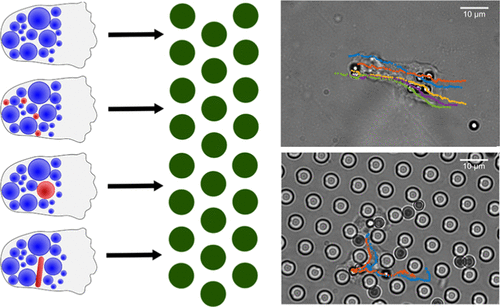当前位置:
X-MOL 学术
›
ACS Biomater. Sci. Eng.
›
论文详情
Our official English website, www.x-mol.net, welcomes your
feedback! (Note: you will need to create a separate account there.)
Migration of Microparticle-Containing Amoeba through Constricted Environments
ACS Biomaterials Science & Engineering ( IF 5.4 ) Pub Date : 2020-01-13 , DOI: 10.1021/acsbiomaterials.9b00496 Michael Timmermann 1 , Nils Lukat 1 , Lindsay P. Schneider 1 , C. Wyatt Shields 2, 3 , Gabriel P. López 2, 4 , Christine Selhuber-Unkel 1
ACS Biomaterials Science & Engineering ( IF 5.4 ) Pub Date : 2020-01-13 , DOI: 10.1021/acsbiomaterials.9b00496 Michael Timmermann 1 , Nils Lukat 1 , Lindsay P. Schneider 1 , C. Wyatt Shields 2, 3 , Gabriel P. López 2, 4 , Christine Selhuber-Unkel 1
Affiliation

|
In many situations, cells migrate through tiny orifices. Examples include the extravasation of immune cells from the bloodstream for fighting infections, the infiltration of cancer cells during metastasis, and the migration of human pathogens. An extremely motile and medically relevant type of human pathogen is Acanthamoeba castellanii. In the study presented here, we investigated how a combination of microparticles and microstructured interfaces controls the migration of A. castellanii trophozoites. The microinterfaces comprised well-defined micropillar arrays, and the trophozoites easily migrated through the given constrictions by adapting the shape and size of their intracellular vacuoles and by adapting intracellular motion. After feeding the trophozoite cells in microinterfaces with synthetic, stiff microparticles of various sizes and shapes, their behavior changed drastically: if the particles were smaller than the micropillar gap, migration was still possible. If the cells incorporated particles larger than the pillar gap, they could become immobilized but could also display remarkable problem-solving capabilities. For example, they turned rod-shaped microparticles such that their short axis fit through the pillar gap or they transported the particles above the structure. As migration is a crucial contribution to A. castellanii pathogenicity and is also relevant to other biological processes in microenvironments, such as cancer metastasis, our results provide an interesting strategy for controlling the migration of cells containing intracellular particles by microstructured interfaces that serve as migration-limiting environments.
中文翻译:

含微粒变形虫在狭窄环境中的迁移
在许多情况下,细胞会通过微小的孔口迁移。例子包括免疫细胞从血液中渗出以抵抗感染,癌细胞在转移过程中的浸润以及人类病原体的迁移。一种极能动和医学上相关的人类病原体是棘形棘阿米巴。在这里提出的研究中,我们调查了微粒和微结构界面的组合如何控制A. castellanii的迁移滋养体。微界面包括明确定义的微柱阵列,并且滋养体通过适应其细胞内液泡的形状和大小以及适应细胞内运动而容易地通过给定的狭窄处迁移。用各种大小和形状的合成硬质微粒将滋养体细胞喂入微界面后,其行为发生了巨大变化:如果这些微粒小于微柱间隙,则仍有可能迁移。如果单元格包含的粒子大于柱间隙,它们可能会被固定,但也可能显示出出色的解决问题的能力。例如,他们将棒状微粒变成短轴穿过柱间隙,或者将微粒运输到结构上方。由于移徙对A. castellanii的致病性,也与微环境中的其他生物过程有关,例如癌症转移,我们的结果提供了一种有趣的策略,可通过用作迁移限制环境的微结构界面控制含细胞内颗粒的细胞的迁移。
更新日期:2020-01-13
中文翻译:

含微粒变形虫在狭窄环境中的迁移
在许多情况下,细胞会通过微小的孔口迁移。例子包括免疫细胞从血液中渗出以抵抗感染,癌细胞在转移过程中的浸润以及人类病原体的迁移。一种极能动和医学上相关的人类病原体是棘形棘阿米巴。在这里提出的研究中,我们调查了微粒和微结构界面的组合如何控制A. castellanii的迁移滋养体。微界面包括明确定义的微柱阵列,并且滋养体通过适应其细胞内液泡的形状和大小以及适应细胞内运动而容易地通过给定的狭窄处迁移。用各种大小和形状的合成硬质微粒将滋养体细胞喂入微界面后,其行为发生了巨大变化:如果这些微粒小于微柱间隙,则仍有可能迁移。如果单元格包含的粒子大于柱间隙,它们可能会被固定,但也可能显示出出色的解决问题的能力。例如,他们将棒状微粒变成短轴穿过柱间隙,或者将微粒运输到结构上方。由于移徙对A. castellanii的致病性,也与微环境中的其他生物过程有关,例如癌症转移,我们的结果提供了一种有趣的策略,可通过用作迁移限制环境的微结构界面控制含细胞内颗粒的细胞的迁移。











































 京公网安备 11010802027423号
京公网安备 11010802027423号